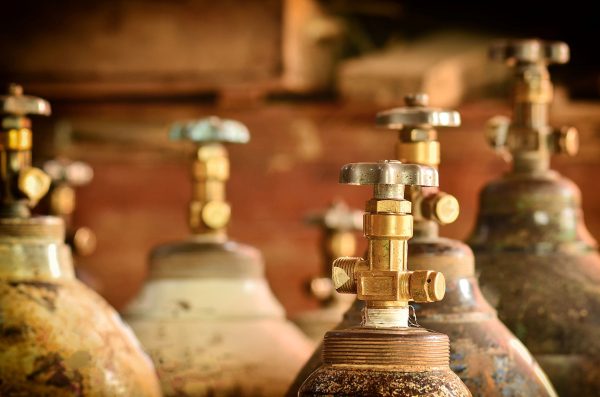
Helium cylinder storage cages provide secure containment for compressed gas cylinders in industrial, commercial, and laboratory settings. These specialized storage units prevent unauthorized access, protect cylinders from damage, and help facilities maintain OSHA compliance. Proper storage of helium cylinders reduces workplace hazards and extends the lifespan of expensive gas containers.
Helium is stored under high pressure, typically between 2,000 and 2,500 PSI, making proper storage a safety priority. Storage cages keep cylinders upright, protected from impact, and separated from incompatible materials. Facilities that use helium for welding, balloon inflation, leak detection, or medical applications need reliable storage solutions that meet regulatory requirements.
Understanding Gas Cylinder Storage Requirements
OSHA mandates that compressed gas cylinders be stored in well-ventilated areas away from heat sources and incompatible materials. Cylinders must be secured to prevent falling, and full cylinders should be separated from empty ones. Storage cages fulfill these requirements by providing dedicated, lockable spaces designed specifically for gas cylinder containment.
Helium is an inert gas, but the cylinders themselves pose physical hazards if mishandled. A falling cylinder can become a dangerous projectile, and damaged valves can cause rapid decompression. Storage cages minimize these risks through secure construction and proper design.
Benefits of Dedicated Cylinder Storage Cages
Investing in proper storage infrastructure protects both personnel and equipment. Storage cages offer several advantages over improvised storage methods:
- Enhanced Safety: Cages prevent cylinders from tipping or rolling, reducing injury risk from falling containers or damaged valves
- Regulatory Compliance: Purpose-built storage helps facilities meet OSHA, NFPA, and local fire code requirements
- Security: Lockable designs prevent unauthorized access and reduce theft risk
- Organization: Designated storage locations improve inventory management and workflow efficiency
- Weather Protection: Outdoor-rated cages shield cylinders from environmental damage while maintaining ventilation
Construction and Design Features
Quality gas cylinder storage cages use heavy-gauge steel construction with powder-coated or galvanized finishes for corrosion resistance. Mesh or perforated sides provide ventilation while maintaining visibility of stored contents. Door designs typically include padlock hasps or integrated locking mechanisms.
Cage capacity varies from single-cylinder units to large enclosures holding dozens of tanks. Common sizes accommodate standard industrial gas cylinders, including smaller lecture bottles and larger K-size cylinders. Floor designs allow forklift access for moving heavy cages, while base channels prevent cylinder rolling.
Many cages include chain sets or restraining straps to secure cylinders individually. This prevents movement during transport or seismic events. Some designs feature separate compartments for full and empty cylinder segregation.
Applications Across Industries
Manufacturing facilities use helium for leak testing, welding shielding gas, and heat treating processes. Proper storage keeps production running smoothly while maintaining safety standards. Medical facilities require helium for MRI machines and respiratory treatments, where secure storage protects expensive gas supplies.
Laboratories conducting research or analytical testing use helium as a carrier gas for chromatography and mass spectrometry. Storage cages protect these supplies from contamination and unauthorized use. Event companies and party supply businesses store helium cylinders for balloon inflation, requiring secure storage between jobs.
Diving operations use helium in breathing gas mixtures for deep diving. Storage cages keep these cylinders organized and protected at dive shops and training facilities.
Best Storage Practices for Helium Cylinders
Following proper storage protocols extends cylinder life and maintains safety:
- Store cylinders in upright positions with valve caps in place
- Keep storage areas well-ventilated and away from heat sources exceeding 125°F
- Separate full and empty cylinders with clear labeling
- Maintain clear pathways around storage cages for emergency access
- Inspect cylinders regularly for damage, corrosion, or expired test dates
- Keep flammable materials at least 20 feet away from storage locations
Maintenance and Inspection
Storage cages require regular inspection to ensure continued protection. Check welds and joints for cracks or damage that could compromise structural integrity. Examine locks and latches to confirm proper operation. Clean accumulated dirt or debris that might trap moisture and accelerate corrosion.
Inspect the floor area inside cages for signs of leaking cylinders, such as frost formation or hissing sounds. Replace damaged chains or straps used for cylinder restraint. Touch up paint or coating on scratched areas to prevent rust development.
Choosing the Right Storage Solution
Anthony Carts manufactures gas cylinder storage cages designed for helium and other compressed gases. Our cages meet industry safety standards while providing the durability needed for demanding work environments. Whether you need storage for a single cylinder or an entire inventory, we have solutions sized for your operation.
Consider your facility’s specific needs when selecting storage cages. Factor in the number of cylinders, available floor space, indoor or outdoor placement, and local code requirements. Proper storage infrastructure is an investment in workplace safety and operational efficiency. Contact Anthony Carts today to find the right gas cylinder storage cage for your helium storage needs.

